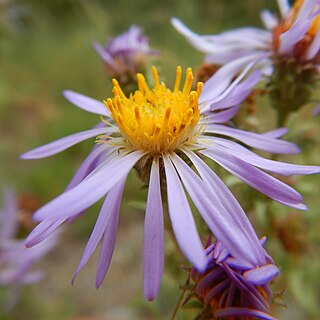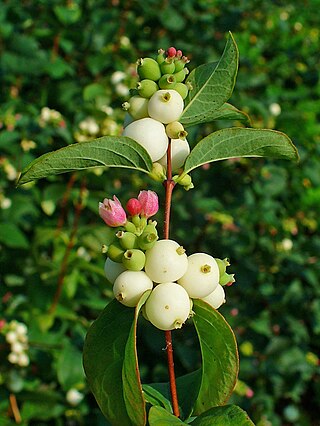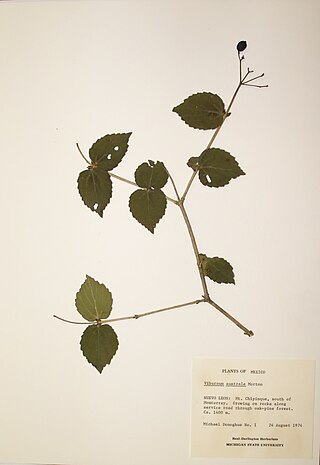
Maianthemum dilatatum is a common rhizomatous perennial flowering plant that is native to western North America from northern California to the Aleutian islands, and Asia across the Kamchatka Peninsula, Japan, and Korea. It grows in coastal temperate rainforests, and is often the dominant groundcover plant in Sitka Spruce forests.

Viburnum lantana, the wayfarer or wayfaring tree, is a species of Viburnum, native to central, southern and western Europe, northwest Africa, and southwestern Asia. The vigorous deciduous European treelike shrub is common along waysides.

Vaccinium uliginosum is a Eurasian and North American flowering plant in the heath family Ericaceae.

Shepherdia argentea, commonly called silver buffaloberry, bull berry, or thorny buffaloberry, is a species of Shepherdia in the Oleaster family. It is native to central and western North America.

Viburnum rhytidophyllum, the leatherleaf viburnum, is a species of flowering plant in the family Viburnaceae. It is native to Asia.
Amelanchier humilis, commonly known as the low shadbush, is a North American species of serviceberry. It is native to central Canada and the northeastern and north-central United States.

Symphyotrichum campestre is a species of flowering plant of the family Asteraceae commonly known as western meadow aster. It is native to much of western North America where it grows in many habitats, generally at some elevation.

Viburnum edule, the squashberry, mooseberry, moosomin, moosewood viburnum, pembina, pimina, highbush cranberry, or lowbush cranberry is a species of shrub. It grows up to 2.5 metres (8 ft) tall and has smooth branches.

Abronia mellifera, the white sand verbena, is a herbaceous perennial flowering plant in the Nyctaginaceae family. It is endemic to the northwestern United States.
Malacothamnus abbottii is a rare species of flowering plant in the mallow family known by the common name Abbott's bushmallow. It is endemic to Monterey County, California, where it has recently been observed at only a few locations. It was historically known from a single specimen collection and the plant was presumed extinct until it was rediscovered in 1990 near San Ardo in the Salinas River drainage. It is now known from eleven occurrences, many of which are actually part of a single population, growing in vulnerable riverbeds near oil fields. Its habitat is periodically flooding riparian scrub among sandbar willows. This is a shrub with a slender, branching stem growing erect to a maximum height over one meter. It is coated in thin white hairs and bears toothed oval leaves a few centimeters long, sometimes divided into lobes. The inflorescence is a cluster of a few pale pink flowers with pointed oval petals 6 or 7 millimeters long.

Neviusia cliftonii is a rare species of shrub in the rose family which is known by the common name Shasta snow-wreath. It is endemic to Shasta County, California, where it is known from about 25 occurrences in the mountains around Lake Shasta.

Quercus cornelius-mulleri is a North American species of oak known by the common name Muller oak, or Muller's oak. It was described to science in 1981 when it was segregated from the Quercus dumosa complex and found to warrant species status of its own. It was named after ecologist Cornelius Herman Muller. It is native to southern California and Baja California, where it grows in chaparral, oak woodlands, and other habitat in foothills and mountains. It can most easily be observed in Joshua Tree National Park and in the woodlands along the western margins of the Colorado Desert in San Diego County, California.

Symphoricarpos albus is a species of flowering plant in the honeysuckle family known by the common name common snowberry. Native to North America, it is browsed by some animals and planted for ornamental and ecological purposes, but is poisonous to humans.

Gouania meyenii is a rare species of flowering plant known by the common name smoothfruit chewstick or Meyen's gouania. It is endemic to Hawaii, where it is known only from Oahu and Kauai. It is estimated that there are between 38 and 63 individuals of this species remaining in the wild. It is a federally listed endangered species of the United States.

Vaccinium pallidum is a species of flowering plant in the heath family known by the common names hillside blueberry, Blue Ridge blueberry, late lowbush blueberry, and early lowbush blueberry. It is native to central Canada and the central and eastern United States.

Viburnum australe, known by the common name Mexican arrowwood, is a woody plant in the family Adoxaceae. It is found in northeastern Mexico and western Texas.

Allium douglasii, the Douglas' onion, is a perennial herbaceous flowering plant in the Amaryllidaceae family. It is native to northeastern Oregon, eastern Washington, and northern Idaho.

Viburnum cassinoides, commonly known as northern wild raisin, blue haw, witherod viburnum, or swamp haw, is a deciduous shrub native to eastern North America in the viburnum family, Viburnaceae. It is often synonymized with Viburnum nudum var. cassinoides.

Viburnum dilatatum, commonly known as linden arrowwood or linden viburnum, is a deciduous shrub in the moschatel family (Adoxaceae). It is native to eastern Asia, and can be found as an introduced plant in the mid-Atlantic regions in the U.S from New York to Virginia. Linden arrowwood is known for the clusters of red drupes it produces when it is mature.

Viburnum recognitum, variously called the northern arrowwood, southern arrowwood, and smooth arrow-wood, is a species of flowering plant in the family Viburnaceae. It is native to eastern Canada, and the central and eastern United States. A shrub or small shrubby tree, they are typically found in wetter habitats such as stream banks, bottomlands, swamps, and mesic woodlands. It is closely related to, and may be a subtaxon of, Viburnum dentatum, the southern arrowwood or roughish arrowwood.



















